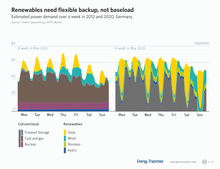Base load

The base load
Power plants that do not change their power output quickly, such as some large coal or nuclear plants, are generally called baseload power plants.[3][6][7] In the 20th century most or all of base load demand was met with baseload power plants,[8] whereas new capacity based around renewables often employs flexible generation.[9]
Description
Grid operators take long and short term bids to provide electricity over various time periods and balance supply and demand continuously.[10] The detailed adjustments are known as the unit commitment problem in electrical power production.[citation needed]
While historically large power grids used unvarying power plants to meet the base load, there is no specific technical requirement for this to be so. The base load can equally well be met by the appropriate quantity of
Unvarying power plants can be coal, nuclear,
The desirable attribute of dispatchability applies to some gas plants and hydroelectricity. Grid operators also use curtailment to shut plants out of the grid when their energy is not needed.[13][14]
Economics

Grid operators solicit bids to find the cheapest sources of electricity over short and long term buying periods.[15]
Nuclear and coal plants have very high
Some coal and nuclear power plants do not change production to match power consumption demands since it is sometimes more economical to operate them at constant production levels, and not all power plants are designed for it. The
Some combined-cycle plants usually fuelled by gas, can provide baseload power,
According to National Grid plc chief executive officer Steve Holliday in 2015, and others, baseload is "outdated".[9][7]. By 2019, Steve Holliday had left his position as CEO of National Grid plc and went on the record to say that, "It’s hard to conceive that nuclear does not have an important role to play"[22]
See also
- Capacity factor
- Energy demand management
- Grid energy storage
- Load balancing (electrical power)
- Smart grid
- Load following power plant
- Peaking power plant
References
- ^ "Review of solutions developed for improving maneuvering flexibility in German, French and Russian PWRs targeting to explore future possibilities for the new VVER-1200 nuclear power plant units in Hungary".
- ^ "Definition of "baseload"". www.merriam-webster.com. Merriam Webster Dictionary. Retrieved 2018-12-02.
- ^ ISBN 9780070209749, pp. 12-16 through 12-18
- ^ a b Peters, Roger, Cherise Burda (2007-09-01). "The Basics on Base Load: Meeting Ontario's Base Load Electricity Demand with Renewable Power Sources" (PDF). Pembina Institute. Retrieved 2018-05-16.
{{cite web}}: CS1 maint: multiple names: authors list (link) - ^ ISSN 1558-8424.
- ^ "Energy Dictionary - Baseload plant". EnergyVortex.com. Archived from the original on 2009-02-15. Retrieved 2008-08-03.
- ^ a b July 10; Alum, 2017 Kevin Steinberger-Alum Miles Farmer-. "Debunking Three Myths About "Baseload"". NRDC. Retrieved 2022-01-29.
{{cite web}}: CS1 maint: numeric names: authors list (link) - ^ "The Baseload Fallacy". Energy Global. 2023-08-02. Retrieved 2024-04-07.
- ^ a b Karel Beckman (11 September 2015). "Steve Holliday CEO National Grid: baseload is outdated". EnergyPost.eu. Archived from the original on 10 September 2016. Retrieved 6 October 2016.
- ISBN 978-0-8213-8822-8.)
{{cite book}}: CS1 maint: multiple names: authors list (link - ^ Nelder, Chris. "Why baseload power is doomed | ZDNet". ZDNet. Retrieved 2018-12-02.
- ^ "Scaling Geothermal for Reliable Baseload Power". renewableenergyworld.com. 2007-10-05. Archived from the original on 2018-07-01. Retrieved 2008-08-03.
- ISSN 1364-0321.
- ^ GIMON, ERIC, ROBBIE ORVIS AND SONIA AGGARWAL (2015-03-23). "Renewables Curtailment: What We Can Learn From Grid Operations in California and the Midwest". Green Tech Media. Retrieved 2018-05-16.
{{cite web}}: CS1 maint: multiple names: authors list (link) - ^ Johnston, David Cay (2014-05-29). "OPINION: How electricity auctions are rigged to favor industry". Al Jazeera. Retrieved 2018-05-16.
- ^ "What is Generation Capacity?". Energy.gov. Retrieved 2022-06-18.
- ISBN 9780773514300. Retrieved 2008-08-03.
- ^ "Accelerating Just Transitions for the Coal Sector – Analysis". IEA. 2024-03-19. Retrieved 2024-04-06.
- ^ Nuclear Development, June 2011, page 10 from http://www.oecd-nea.org/
- ^ "Nuclear Development". www.oecd-nea.org. Nuclear Energy Agency. Retrieved 2018-12-02.
- ^ "A user's guide to natural gas power plants". Utility Dive. Retrieved 2022-06-18.
- ^ Stanley Reed (7 January 2019). "For Wales, Nuclear Plant Would Mean New Jobs. For the U.K., It May Mean More". New York Times.

